Hello yes I would like to do a Cold War
Last time, we dipped our toes into WWIII: Team Yankee to answer the question: what if, violence? This week, we’re dipping our toes in to test the oil-slick waters. Daveydweeb and Sockbert signed up to this unfamiliar wargame in our usual, measured way: by waking up from some kind of fugue state with our literal bodyweight in miniatures on the doorstep and a fistful of credit card statements in the letterbox. It’s time to take your first steps on the battlefields of Eastern Europe. And Scandinavia. And the Middle East. There’s plenty of violence for everyone.
WWIII: Team Yankee might be named after a small company of soldiers in the book that spawned this game, but the starting points for new players are many and varied. You certainly can play as the United States Army if you’d like, and bring to bear the full force of the military-industrial complex of the largest economy on Earth. Or you can play as the Soviet Union, countering the artisanal, small-batch vehicles of the West with more steel and conscripts than you can poke a HEAT shell at. But that’s just scratching the surface! In total, there are currently more than twenty nations with full rule sets.
In this article, we’re going to introduce the various unit types you have available, and the many countries that can field them. We’ll share our experiences with the starter boxes, accessories and rule books and recommend the key items for a good first game. In future articles, we’ll go into much more depth on how to get started with each faction.

Understanding the pieces
Alright, Yuri, it’s time for a language lesson. In World War III, a team is a single vehicle, or a base or stand of infantry. A unit is a collection of teams. Infantry works the same way: there are several infantry teams in a single unit, and they’re often attached to a separate unit of transport vehicles. We found the difference between teams and units to be a bit confusing at first, but you can just remember that a ‘team’ is just a single piece of plastic that you can hold in your hand. A formation is a collection of teams and includes an organisation chart. And finally, your force is your whole army, which always includes one and possibly more formations, and may also include additional teams that exist outside a formation which represent nearby elements that are helping in the fight.
Your army is made up of one or more formations, groups of units that fill out a force structure. They’re a more forgiving version of early Warhammer 40,000 force organisation charts, generally containing a Headquarters team and 2-3 mandatory choices of the same unit type, and can be fleshed out with a range of support options. Formation types are usually built around a specific vehicle or role, and they may be modern, diverse battalions with a healthy range of support options or may only allow variants on a specific type of hull. Each nation has its own formation options, reflecting equipment availability and doctrine, and you need to include at least one formation in your force. You can also include units outside that formation which represent nearby help from the wider armed forces, although units added in this way don’t benefit your force’s morale – which can cause the shattered remnants of a formation to run from a battle. A whole battalion of M1A1 Abrams tanks costs a fortune, but maybe all you need is a single unit and this is the way to do it.

Finally, check out Team Yankee Forces, Team Yankee’s dedicated army builder, which duplicates most of the information from the army books and, apart from the faction books, is your alternative source of information about how to construct formations. This sounds like a microtransaction, but really isn’t; unlocking all the formations for any nation is significantly cheaper than buying the relevant book, and while Battlefront’s digital presence can be a tad, erm, clunky, the army builder is still perfectly functional. We think this is a much more approachable way to learn to build formations than the formation cards included in some of the boxes. Beware, though, that the website developers have had to bodge pretty hard to make some rules fit into Forces. If you’re trying to upgrade your infantry’s Dragon 2 missiles, well… goonspeed to you.

My tanks, let me show you them
So, Yuri, do you want your force to be a superheavy tank sledgehammer, rolling across the battlefield and laughing in a completely normal, fully-hinged sort of way? What about a lightning-fast flanking force of infantry fighting vehicles that sprints into an unexpected quarter to strike at your enemy’s soft underbelly? Maybe you’re an airborne guy, dropping warheads on foreheads? Let’s spend a bit of time talking about the major unit types so we can come up with a force design that suits them.
Tanks are the obvious place to start, and boy are there a lot of tanks. Team Yankee is set in that magical year of 1985 when a T-55 designed in 1947 could realistically expect to be facing a shiny, new French Leclerc tank which entered service in *checks notes* 1992. Modern tanks will have nigh-impenetrable front armour but will be vulnerable from the sides and above, while older vehicles can be at genuine risk from small arms, relying on the adage that quantity has a quality of its own. Meanwhile, Sockbert is building up their new Swedish army with a third defensive mechanism: using sneaky Scandinavian shenanigans to avoid being shot in the first place. Tanks guns are pretty much the best and most powerful firepower on the board, able to reliably kill any smaller land vehicle and potentially threaten the front armour of their equivalents. Infantry can also hitch a ride on them, but remember that against incoming fire the flesh is weak. Tanks can be pricey, but some problems just really need a hammer.
Infantry Fighting Vehicles (IFVs) and Armoured Personnel Carriers (APCs) are a diverse range of lightly armoured vehicles. From state-of-the-art Bradleys all the way down to a redneck pick-up truck, you can take your pick. It’s harder to generalise across so many different offerings, but generally this is where your force will find its speed, flanking ability and surprise. While IFVs aren’t intended to face tanks head-on, a well-placed ambush with anti-tank guided missiles (ATGMs) can absolutely ruin an unprepared tank force. They’re also where you’ll find some good anti-infantry weapons, and a last-resort anti-helicopter option. This is also your source of pre-game movement, and some units can even extend your deployment zone.
Infantry felt unnecessary to us when we first started to play, but my oh my were we wrong about them. These little bastards are for digging in and holding objectives against all odds, and they can sometimes do unspeakable things to tanks that get too close. Infantry have many ways to survive on the battlefield, and there’s nothing better for stubbornly grasping onto a hopeless objective point. There’s also something deeply unnerving about swarms of Iranian Basij or USMC rifle platoons marching relentlessly towards your main battle tanks; you’ll run out of bullets before they run out of bodies.
Artillery is backspace for foot soldiers, and you’re going to need some; nothing else can dig an angry German out of a fox hole quite like it. If you like a wargame that uses hit templates, these are your boys. You have two basic flavours: howitzers and mortars that use the big template, and rocket artillery that use the really big template. A well-placed barrage can reach out and touch a dozen teams or more, and you have a whole range of anti-tank or anti-infantry options to choose from. A lot of vehicles are just as vulnerable as their foot-slogging counterparts; a Leopard 2 is going to laugh at most things trying to take it from the front, but will be glancing nervously to the skies if your enemy has the will to drop a shell on them. Apart from barrages, you’re going to need them to drop smoke to divide up the battlefield and the most advanced guns can even fire laser-guided armour piercing shells or, if you really want to ruin someone’s picnic, saturate an area with mines.
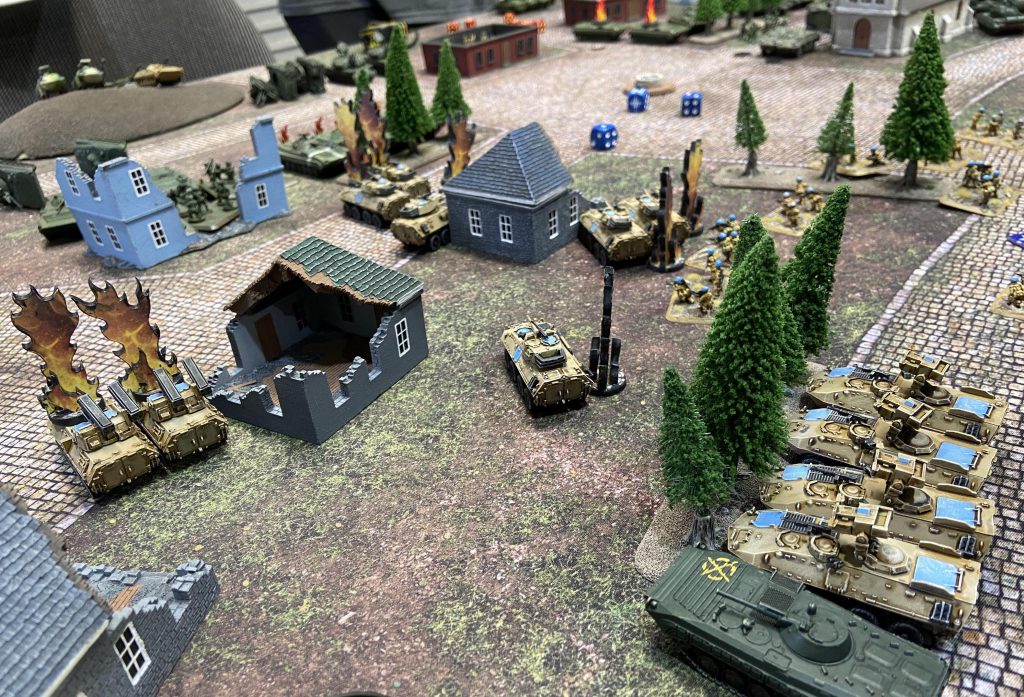
Aircraft are an elegant weapon for a more civilised age. Deciding whether, which, and how many aircraft and air defence units to bring is a thinking goon’s game. Tonight’s menu has two kinds of aircraft: strike aircraft, which might not show up every turn but provide access to a perfectly normal and socially acceptable amount of massive firepower, and helicopters, which are usually a little more modest in the dakka department but considerably more flexible, and can sometimes even carry troops. Both options have infinite movement, letting you place them wherever they’re needed most. Tiresome artillery hiding in a village behind a hill? It’s Apache time.
Anti-air (AA) is the inelegant weapon from a less civilised age, using $30 bullets and $30,000 missiles to ruin multi-million dollar planes’ day. Your basic options are guns and missiles; missiles tend to be longer ranged and better at killing aircraft when they hit, while AA machine guns vomit out a lot of short range, generally lower quality dakka which can also be used on poor innocent ground troops in a definitely-not-a-war-crime sort of way.
Sometimes air and anti-air feel like a bit of a gamble; if you take dedicated anti-air and your opponent doesn’t show up with something for them to shoot at, you’ve just wasted points jumping at shadows. Bring too little thought, and their air force is going to turn your table into the Highway of Death. We’ve seen this happen both ways in real play, and it can be decisive. Despite this, we assert that aircraft are, in purely technical terms, kickin’ rad.
Using these basic tools, you can construct a good range of forces from pretty much any archetype you can imagine. You can aim for a force of fast, hard-hitting IFVs that sprint across the battlefield and surround your enemy, or bricks of dug-in infantry and modern tanks that can take hit after hit. Aerial insertion of airborne troops using dozens of helicopters is totally a thing, jumping out of Hueys and Sea Knights to mop up their artillery-ravaged foes. “Oops, all Humvees” is absolutely an option, but like, maybe take a deep breath first. This way, madness lies.
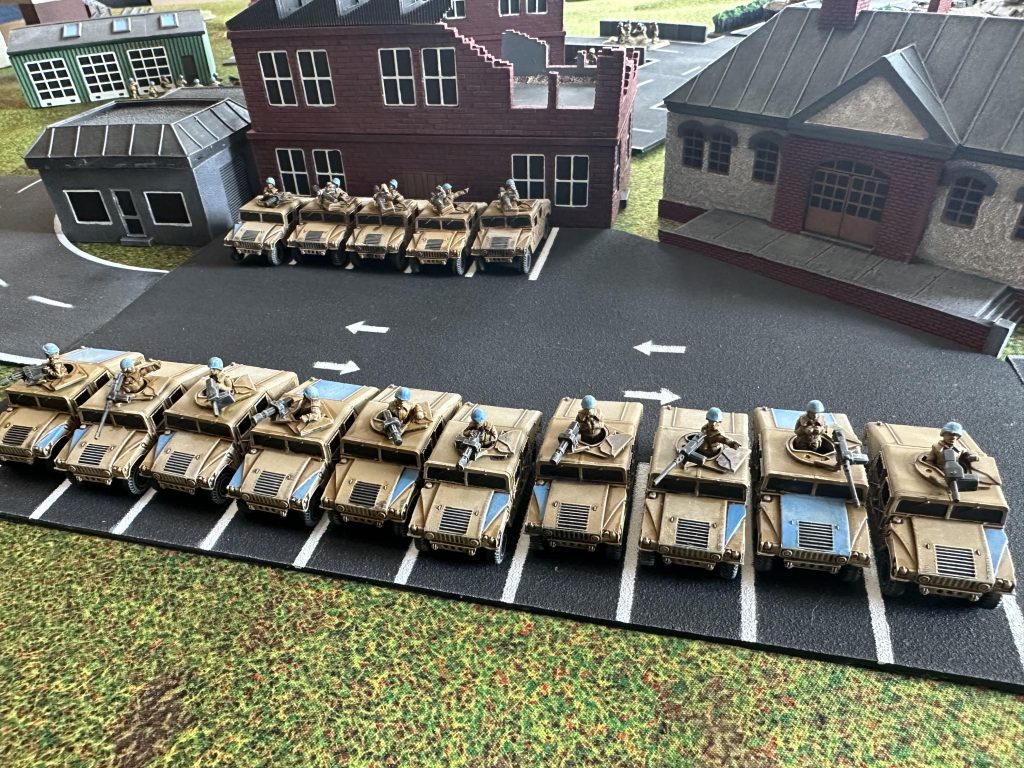
Come on in, the trenches are lovely
So where to start? We can’t possibly cover all of the many starter options that are available today, but the answer is pretty simple anyway: if there’s any chance you’d be interested in playing as Americans, Soviets, or anyone who can ally with them, just get World War III: The Complete Starter Set. If you instead want to play with any of the other two dozen factions available today, we’ll give a quick overview of them in a moment.
The Starter Set is Certified Good Stuff, containing 16 tanks (nine for Soviets, seven for America). You’ll find a valid and useful core for a balanced army of either of those two factions, and a handy collection of accessories to get you playing. The box comes with a complete rule book and mission pack, dice, magnets for the tank turrets (which are not necessary, but are nice), and even printed tokens on the inside of the box lid. It’s a solid offering, and you’re not likely to waste anything out of this box if you’re interested in either of the two factions it contains. Although the selection here is too small for any normal formation, the box includes bespoke rules to allow legal play using only the models it contains.
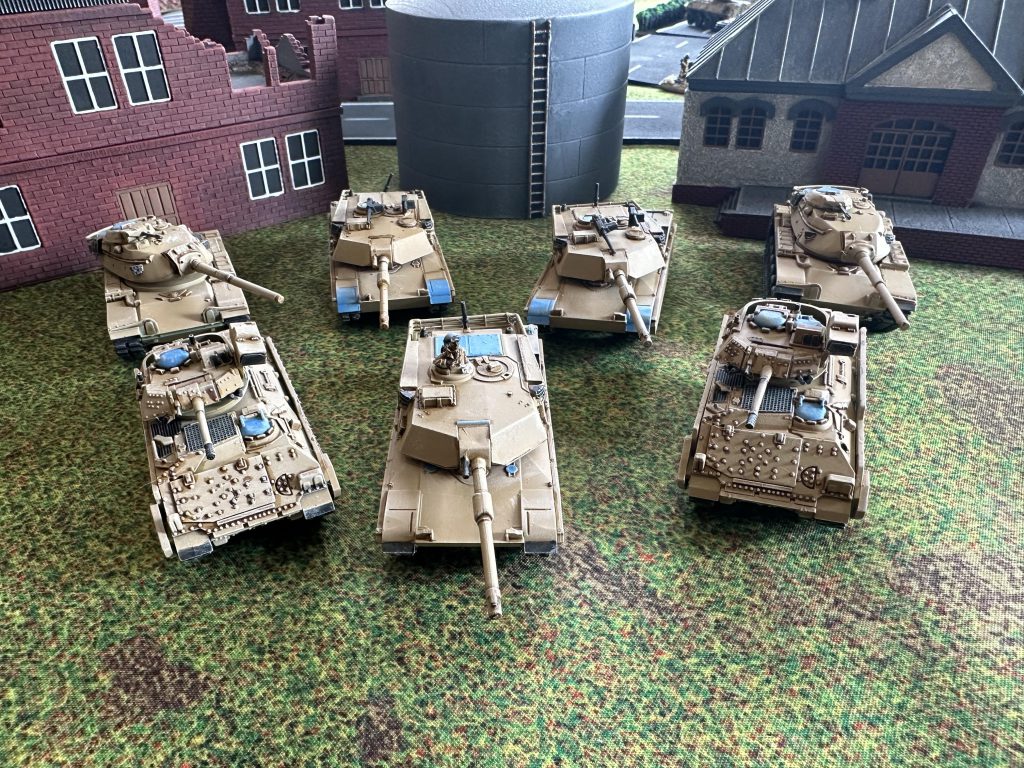
Most factions also have their own starter boxes, but we’ll save discussing them for future Getting Started articles. These boxes don’t contain quite as many little features as the main box, like dice or tokens, and are better seen as a starting point for a specific force design for players who already have, or are separately buying, the other necessary bits and bobs.
If there’s one thing that this game does well, it’s to provide enough stuff to just open the box, build your little guys, and play. First things first, you don’t need to buy a rule-book right away. Although an A4 edition of the core rules is available, every starter box (including the Complete Starter Set) includes an identical (but smaller, A5) version for free. At this point, we have something like six of these between us.
Similarly, you can get away without buying a faction rule book at first. These books are great as a single source of both gameplay and narrative information, as well as painting guides, but the same gameplay information is also provided for free on the unit cards that are included with every miniature, as well most of it on the Forces website. The main reason to buy a faction book is to get a general look at everything a faction can do without having to flip through cards and web pages. Once you’re ready to expand your little force, then it’s time to consider buying one of these.
On the other hand, you are going to need to pick up a few things before you can dive in. You’ll need the obvious wargaming tools (measuring tape, dice), you’re also going to need tokens and templates. Cardboard tokens are provided inside the box lid of the Complete Starter Set, but eventually you’ll need something sturdier. Similarly, find yourself an artillery template. Artillery use a square template which shows both ‘artillery’ or ‘salvo’ sizes and these lads are big. They’re available in either cardboard or plastic and having one available is going to make play much simpler.
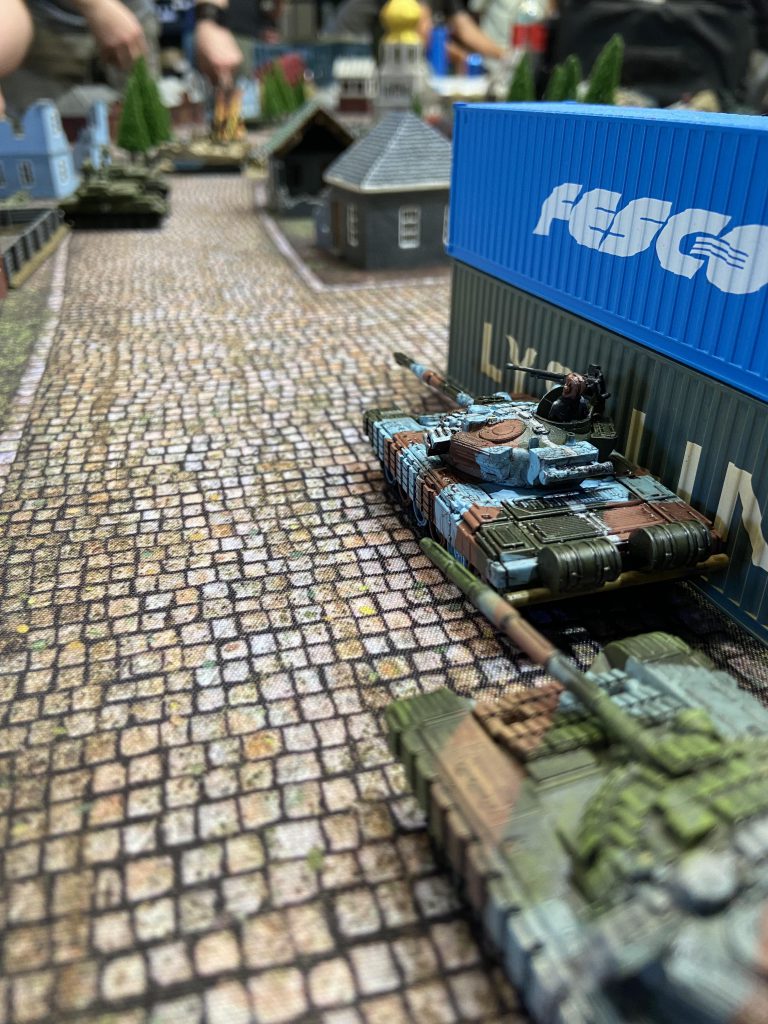
The many faces of war
World War III is a big war in a big game, and you’ve got oh so many factions to choose from. On top of the Soviet and American units in the Starter Set, nine books provide the rules, formation structures and narrative for one or more of the factions. Here’s a quick rundown!
NATO-aligned books
- The American book covers the largest selection of hardware in the game, ranging from the heaviest (and most expensive) tanks to Army and Marine Corps infantry, flyers and artillery. These guys are your Astartes; better than average but not necessarily the best in class, and with a hefty price tag to match.
- The British book smells of colonialism and tea, letting you bring a fairly condensed but elegant list of formations and units and asking you not to smirk as you field formations called things like the Queen’s Own Yeomanry. The Brits bring resilient infantry, decent and varied armour choices, good man-portable anti-tank, a range of light vehicles like Foxes, Scorpions and Scimitars, and by King George’s beard, these lads are a bit of alright in melee. English soldiers have some “experience” in Ireland during this time period, and they’re not afraid to show it on the tabletop.
- West Germany is a somewhat elite option for the Europeans – they offer middling to decent tanks, excellent IFVs, and very good morale across the board. They benefit from high rates of fire and good firepower, but their generally mediocre armour means you’ll need to focus on positioning and movement to play to their strengths. Most importantly, some of their tanks are objectively the best looking vehicles ever crafted by man.
- Nordic Forces covers NATO members Norway and Denmark, and their neutral friends Sweden and Finland who decided to pile in for a good scrap. This book contains some funky kit (hi S-Tank!) and force structures that make it really easy to include foreign units. If you want to play the Finns, for example, you can also take Swedish allies and also dust off Soviet kit purchased as part of their policy of “we’ll give you money if you won’t invade”. Why play one army when you can play all of them?
- NATO Forces covers the North Atlantic nations of Canada, France, the Netherlands, Belgium and, uh, Australia and New Zealand. “North Atlantic” might be a bit of a stretch, but we’re in Eurovision, okay? Stop asking questions. Between them, these guys cover most kit available to the West, with a few little tweaks made by each nation to suit their own eccentric needs. The US may have LAV platoons, but you know what the Aussies have? Better LAV platoons, for the same price. Take that, capitalism!
Soviet-aligned books
- Soviet Union covers the big bad guys of the war. The Soviets of Team Yankee have an exciting range of vehicles and force designs at bargain basement prices, but in general this is balanced by them being wildly incompetent. The key benefit to Soviets as your first faction is that they can use pretty much anything that can also be used by any of their allies, but the reverse is not necessarily true. They offer flexibility and accessibility, at the cost of low skill, all burning with a fervent lust for all things red.
- Warsaw Pact are the junior partners in the Communist experiment. They have access to only a subset of the Soviet vehicle range, relying on hand-me-downs that were good enough for grandpa so they’re good enough for you, Yuri. The book covers East Germany, Czechoslovakia and Poland, each of them with their own take on combined arms – and some of them actually do it better than the Soviets. Take that, communism!
Mixed books
- Oil War sees NATO and the USSR insert themselves into the ever peaceful and uncomplicated setting of the Middle East. In this strange universe, Iran’s new hyper-religious Ayatollah teams up with Syria and the ardently atheist USSR, while Israel and, um, Iraq join forces with NATO. It’s a bit of a weird one, but the point is that here you have a book where Iran and Iraq can field both Soviet and NATO kit, Israel can bring a range of Wünderwaffen and some of the coolest looking tanks in the game, and also Syria is there too, I guess.
- Red Dawn is an odd book; it has a lot of Soviet kit, as well as rules for Cuba, but also covers the narrative of the invasion of the USA and Canada, rules for airborne forces and scenarios, and also domestic US militia. It’s almost like the book title is referencing something…
Really, the answer to the question of “what army should I play” is “whatever nation you think you’d enjoy most”. You can build competent armies out of all these nations, and while some of these may struggle more than others in a tournament setting (sorry Cuba, your Soviet overlords have better guns than you), that’s no reason to not lean into whichever you think is coolest.
Just look at your hosts, Sockbert and Davey. Sockbert started with the US side of the Starter Set, and has taken the measured and reasonable approach of expanding into a complete Swedish force with all the dignity and self respect of a wooly mammoth with an attention disorder and no limit on its credit card. Davey, meanwhile, has bravely decided to expand from the Soviets into… Soviets. Like, a lot more Soviets. The dude likes what he likes, okay?
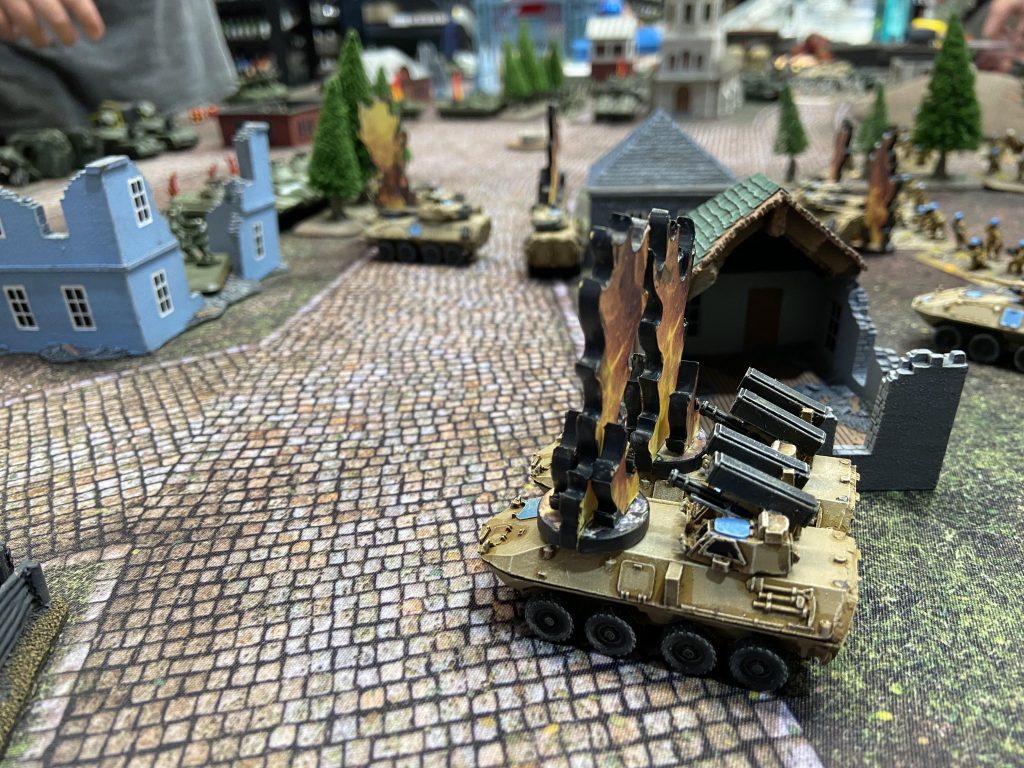
Hi-ho, hi-ho, it’s off to war we go
So that’s a little taste of what a World War III: Team Yankee force might be and who might live inside one. Next up, we’ll be Getting Started with the factions we play – giving more detail on the available starter boxes, next steps and major force archetypes. We’re really excited to fill you in on how we’ve built our armies to date, and how they’ve played. Anyway, it’s cold outside and the engine’s hot – get in, we’re going for a ride.
Have any questions or feedback? Have a topic you want to see us cover in a Historicals article? Drop us a note in the comments below or email us at contat@goonhammer.com.


